This article relies largely or entirely on a single source .(February 2022) |
Jose Antonio Arizabalo Orobio (Gipuzkoa, around 1784 - after 1834) was a Spanish military who played an important role in the Spanish American wars of independence.
This article relies largely or entirely on a single source .(February 2022) |
Jose Antonio Arizabalo Orobio (Gipuzkoa, around 1784 - after 1834) was a Spanish military who played an important role in the Spanish American wars of independence.
Still a child, at the age of seven, he moved with his family to Venezuela, Arizabalo began his military career in Puerto Rico as Artillery commander. From Puerto Rico went to Santo Domingo in 1809 to fight the French.
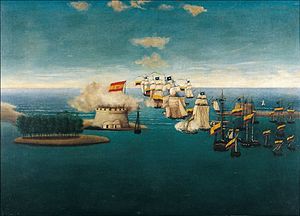
Already lieutenant, he left Santo Domingo in October 1813, and joined the Artillery unit of Caracas. He arrived in Puerto Cabello, in March 1814, coinciding with the siege of Puerto Cabello where his grandfather died. He was in La Guaira, Cumana and Maracaibo, where he fought against the Patriots. In 1819 he was 35 years of age, and as lieutenant colonel of infantry and artillery commander of Fort San Carlos de la Barra in Lake Maracaibo, participated in the capitulation of Francisco Tomás Morales after the Battle of Lake Maracaibo (1823). He was banished to Puerto Rico, with the rest of the Royalist troops in Venezuela.
From Puerto Rico he returned secretly to Venezuela between 1827 and 1829 and organized a guerrilla with the title of commanding general of the Royalist troops "Costa Firme". With little or no support from the Spanish Caribbean fleet of Angel Laborde, based in Puerto Rico which was ruled by Miguel de la Torre, finally on 18 August 1829, without any hope of success, and after spending many hardships, Joseph Arizabalo capitulated to Republican General Lorenzo Bustillos, being reshipped in La Guaira.
An other Royalist guerrilla band continued to fight under command of the indigenous leader José Dionisio Cisneros, who since 1821 had separated his band from the regular troops, and fought until capitulation to Paez in the year 1831. When King Fernando VII died in 1833, all projects of Spanish reconquest of Venezuela came to an end.
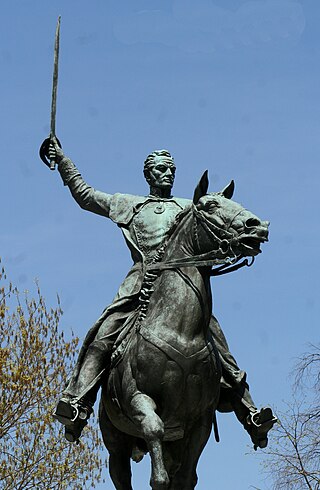
The military and political career of Simón Bolívar, which included both formal service in the armies of various revolutionary regimes and actions organized by himself or in collaboration with other exiled patriot leaders during the years from 1811 to 1830, was an important element in the success of the independence wars in South America. Given the unstable political climate during these years, Bolívar and other patriot leaders, such as Santiago Mariño, Manuel Piar, José Francisco Bermúdez and Francisco de Paula Santander often had to go into exile in the Caribbean or nearby areas of Spanish America that at the moment were controlled by those favoring independence, and from there, carry on the struggle. These wars resulted in the creation of several South American states out of the former Spanish colonies, the currently existing Venezuela, Colombia, Ecuador, Peru and Bolivia, and the now defunct Gran Colombia.
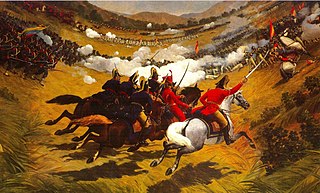
The Venezuelan War of Independence was one of the Spanish American wars of independence of the early nineteenth century, when independence movements in South America fought a civil war for secession and against unity of the Spanish Empire, emboldened by Spain's troubles in the Napoleonic Wars.

The Battle of Carabobo, on 24 June 1821, was fought between independence fighters, led by Venezuelan General Simón Bolívar, and the Royalist forces, led by Spanish Field Marshal Miguel de la Torre. Bolívar's decisive victory at Carabobo led to the independence of Venezuela and establishment of the Republic of Gran Colombia.

Puerto Cabello is a city on the north coast of Venezuela. It is located in Carabobo State, about 210 km west of Caracas. As of 2011, the city had a population of around 182,400. The city is home to the largest and busiest port in the country and is thus a vital cog in the country's vast oil industry. The word 'cabello' translates to 'hair'. The Spanish took to saying that the sea was so calm there that a ship could be moored to the dock with a single hair.

The Battle of Lake Maracaibo also known as the "Naval Battle of the Lake" was fought on 24 July 1823 on Venezuela's Lake Maracaibo between fleets under the commands of Republican Admiral José Prudencio Padilla and royalist Captain Ángel Laborde.

Admiral José Prudencio Padilla López ) was a Neogranadine military leader who fought in the Spanish American wars of independence and a hero in the battles of independence for Gran Colombia .
He was the foremost naval hero of the campaign for independence led by Simón Bolívar, and the creator of the first Navy and Admiral of Great Colombia. He is best known for his victory in the Battle of Lake Maracaibo on 24 July 1823, in which a royalist Spanish fleet was defeated.
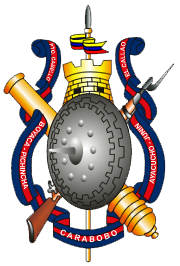
The Venezuelan Army, officially the Bolivarian Army of Venezuela, is the land arm of the National Bolivarian Armed Forces of Venezuela. Also known as Bolivarian Army, its role is to be responsible for land-based operations against external or internal threats that may put the sovereignty of the nation at risk. The army is the second largest military branch of Venezuela after the Bolivarian Militia.

The Captaincy General of Venezuela, also known as the Kingdom of Venezuela, was an administrative district of colonial Spain, created on September 8, 1777, through the Royal Decree of Graces of 1777, to provide more autonomy for the provinces of Venezuela, previously under the jurisdiction of the Audiencia of Santo Domingo and then the Viceroyalty of New Granada. It established a unified government in political (governorship), military, fiscal (intendancy), ecclesiastical (archdiocese) and judicial (audiencia) affairs. Its creation was part of the Bourbon Reforms and laid the groundwork for the future nation of Venezuela, in particular by orienting the province of Maracaibo towards the province of Caracas.

Pablo Morillo y Morillo, Count of Cartagena and Marquess of La Puerta, a.k.a. El Pacificador was a Spanish general. He fought against French forces in the Peninsular War. After the restoration of the Spanish Monarchy, Morillo led an expedition with the goal to restore absolutism in Spain's possessions in the Americas.

Juan Domingo de Monteverde y Rivas, commonly known as Domingo de Monteverde, was a Spanish soldier, governor and Captain General of Venezuela from June 1812 to 8 August 1813. Monteverde was the leader of Spanish forces in the Venezuelan War of Independence from 1812 to 1813. Monteverde led the military campaign that culminated in the fall of the First Republic of Venezuela in 1812. One year later in 1813, Monteverde was defeated by Simón Bolívar during the Admirable Campaign.
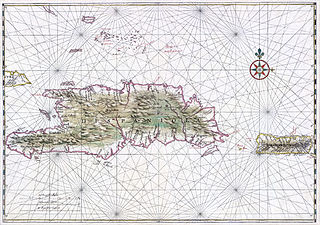
Spanish reconquest of Santo Domingo was the war for Spanish reestablishment in Santo Domingo, or better known as the Reconquista, and was fought between November 7, 1808, and July 9, 1809. In 1808, following Napoleon's invasion of Spain, the criollos of Santo Domingo revolted against French rule and their struggle culminated in 1809 with a return to the Spanish colonial rule for a period commonly termed España Boba.

Fortín Solano is an eighteenth-century colonial fortification overlooking Puerto Cabello, Venezuela. With the Castillo San Felipe, an earlier fort built at sea level, it formed part of a complex of fortifications designed to protect Puerto Cabello and its important harbour from naval attacks. It was constructed c. 1766 by order of Don José Solano y Bote on behalf of the King of Spain. It has been described as the last military construction built in Venezuela during the colonial era.
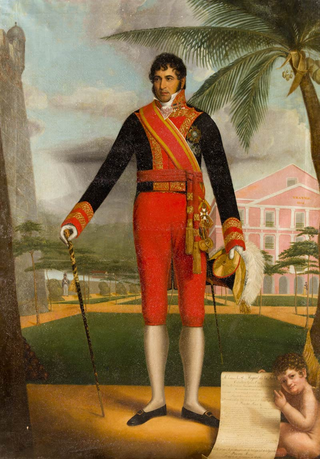
Miguel de la Torre y Pando, conde de Torrepando was a Spanish General, Governor and Captain General, who served in Spain, Venezuela, Colombia and Puerto Rico during the Spanish American wars of independence and afterwards.
This is a timeline of events related to the Spanish American wars of independence. Numerous wars against Spanish rule in Spanish America took place during the early 19th century, from 1808 until 1829, directly related to the Napoleonic French invasion of Spain. The conflict started with short-lived governing juntas established in Chuquisaca and Quito opposing the composition of the Supreme Central Junta of Seville. When the Central Junta fell to the French, numerous new Juntas appeared all across the Americas, eventually resulting in a chain of newly independent countries stretching from Argentina and Chile in the south, to Mexico in the north. After the death of the king Ferdinand VII, in 1833, only Cuba and Puerto Rico remained under Spanish rule, until the Spanish–American War in 1898.

Juan Sánchez Ramírez was a Dominican soldier who served as the Captain general of the modern Dominican Republic between 1808 and 1811. He also commanded the troops that fought against the French rule of Santo Domingo´s colony between 1808 and 1809 in the Battle of Palo Hincado, resulting in a victory over the French, and the return of Santo Domingo to Spanish hands.

The Bombardment of Fort San Carlos occurred during the Venezuelan Crisis on January 17, 1903, when two warships of the Imperial German Navy tried to penetrate into Lake Maracaibo but were repulsed by the garrison of Fort San Carlos de la Barra after a brief exchange of fire.
Francisco Tomás Morales, was a Spanish military, and the last of that country to hold the post of Captain General of Venezuela, reaching the rank of field marshal during the Venezuelan War of Independence.

San Felipe Castle is an eighteenth-century star fort protecting Puerto Cabello in Venezuela. It was named in honour of Philip V, King of Spain at the time of its construction in the 1730s. It has an alternative name Castillo Libertador, explained by its connection with Simón Bolívar, known as El Libertador because of his role in Latin American independence.
Basque Venezuelans are citizens of Venezuela who are of Basque ancestry.
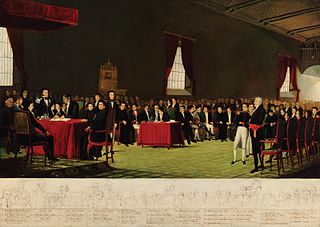
The Venezuelan independence was the juridical-political process that put an end to the ties between the Captaincy General of Venezuela and the Spanish Empire. It also implied the replacement of the absolute monarchy by the republic as the form of government in Venezuela.